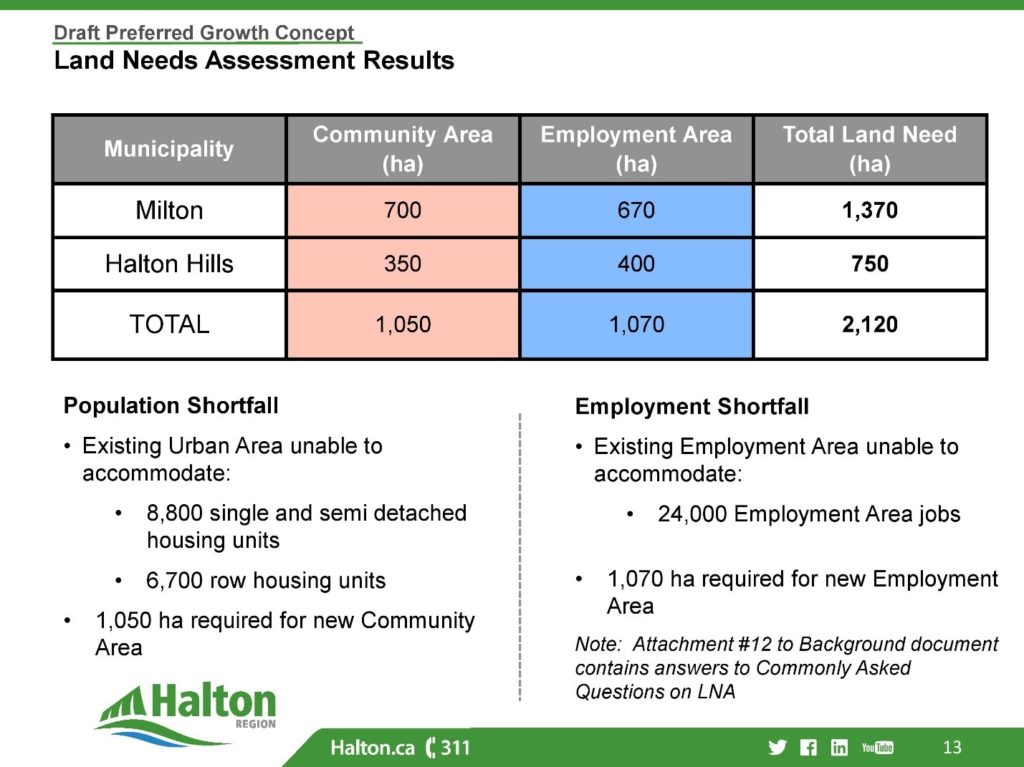Analysis.
By Paul Sharman
Halton is working towards completing an update of its Regional Official Plan for the period 2031 to 2051. A major decision will be made on February 9, 2022, by Halton Regional Council that will formalize population growth targets of each of Halton’s four lower-tier municipalities (Burlington, Halton Hills, Milton, and Oakville) from today through 2051. It will also determine what land will be converted from one use to another.
Key to February 9 decisions is the fact that the Province of Ontario has already allocated a legally-mandated Halton population growth target of 1.1 million people by the end of 2051. The province has also established many other criteria; for example, one is that the plan must meet population density targets in order to minimize urban sprawl, another is that the plan must meet reasonable market expectations in terms of the nature of housing to be permitted, including apartments, row houses, and single-family homes, etc. Finally, the province has to approve the regional plan and has the authority to over-ride any aspects of what the region submits and demand modifications.
The Region of Halton’s 2051 plan is controversial because in order to satisfy provincial reasonable market expectations requires land that is presently used for agriculture or non-development purposes to be converted to residential and employment use. A vocal proportion of community members are opposed to any such conversion, for a variety of reasons.
All pertinent and extremely detailed information about the current regional planning process can be accessed online here.
Recently, a group of activist community members who are opposed to conversion of land for development started an email campaign to members of council to persuade them to vote against the recommendation. They are advocating for options that exclude conversion of previously non-development land.
How did we get here?
Staff and council began this process about four years ago. You can examine all of the many reports that council has reviewed and approved at the online link above. It has been a huge undertaking. To facilitate the decision-making process, staff created five different growth concepts, each with different characteristics, to be considered by council (see Figure 1).

Having examined and compared every different concept with each other and to provincial requirements, staff provided a preferred concept recommendation that will form the basis of the February 9 decision. You can see a staff presentation that summarizes the details of the preferred concept report here.
The preferred concept represents a balance between the earlier five. It satisfies provincial regulations but requires conversion of land for residential and employment use in Halton Hills and Milton only. Halton Hills and Milton councils both support the recommended preferred concept. See Figure 2 for the recommended population distribution to all municipalities and Figure 3 for Halton Hills and Milton land conversion recommendations.


My response
Recently, I and all other members of Halton Regional Council have received hundreds of emails. In fact, they have been filling my inbox for days now. Relatively few have originated from Burlington community members; most are from Oakville with Halton Hills and Milton community members also represented. The curiosity has been that people from other regions and even other provinces have sent emails. It would have been more considerate and a more usual way to express opinions to elected officials via a petition. Keeping in mind the region had already conducted a comprehensive survey here. The survey was completed by 1330 people, 0.2% of the population of Halton.
I have attempted to reply to all emails that I received from residents of Burlington. Here is my reply:
“Dear Burlington Friend and Neighbour:
Thank you for your email regarding release of land for housing in the new Region Official Plan leading to 2051. I respect and understand your concerns. I and my Burlington Council colleagues have received hundreds of emails from Halton residents in response to the campaign initiated by concerned residents. I am only addressing this subject from the perspective of Burlington in this response.
Both Region and City members of Council are committed to maintain rural Burlington as it is. There are no plans to allow housing in our rural lands other than as is currently permitted. Release of land is proposed by the Region in Milton and the Halton Hills only, not Burlington.
Official Plans (OP) have extensive analysis and regulations to ensure existing protection remains in place. You will find OP details for Burlington here https://www.burlington.ca/en/services-for-you/Official-Plan.asp
This is a challenging issue for us all. There are a number of factors that have to be considered:
- The first is that the Region of Halton is obliged to craft a plan that satisfies the province’s 1.1m population requirement by 2051.
- The second is that the Region must provide substantiation that the plan will satisfy market demand. Scenarios 3a and 3b, which have been considered, provided for significantly greater % of apartment units and very few ground-oriented homes than other scenarios and could not satisfy the market test. Indeed, the recent preferred scenario is barely representative of anticipated demand. Keep in mind that Canadian dream is to live in a house with a garage and a yard, as you will understand. The preferred solution is a compromise.
- The third is that because Burlington is essentially built out, we receive all residual population growth that cannot be accommodated in Oakville, Milton and Halton Hills in what ever scenario is selected. In scenario 3a and 3b, that would mean in excess of 80,000 new residents moving into Burlington by 2051, like it or not.
Because Burlington is essentially already built out, under scenario 3b, Burlington will have no other choice but to accommodate about 90% of new residents in 200/300 mid to high rise apartment buildings. That would happen in 5 strategic growth areas of Appleby GO, Burlington GO, Aldershot GO, Up Town (Upper Middle Road and Appleby Line) and Downtown Burlington. We do not know what the distribution of those apartment buildings will be yet, but it certainly means significant densification of all five locations. It creates a tenuous outlook for all five, including downtown, by the standards of most Burlington residents.
The preferred scenario; 1) satisfies Provincial tests to accommodate foreseeable market demand, providing homes for a small number of families who wish to live in a home with a backyard and a garage. That means the Province will likely approve the plan, but not 3a or 3b; 2) increases the number of people who will live in newly constructed apartments representing about 60% across the Region, but more like 90% in the City of Burlington, which is essentially what you are advocating for. Reducing the Burlington allocation to 70,200 population lowers the number of apartment buildings by 25 to 37.5 buildings, providing a bit of a breather to the community. Please take a moment to visualize what the Burlington skyline, living conditions and congestion is likely to become, even under the preferred scenario.
Keep in mind, this plan follows the 2018 election when the people of Burlington spoke out clearly that they do not wish to see “over intensification” of their hometown. It is not what anyone wanted.
In any event, the City will experience increasing numbers of apartments not only between now and 2051 but even more for years too come. The same will be true for the other Halton municipalities. The preferred scenario simply delays inevitable further densification of Halton.
I will be pleased to discuss this with you if that will help. Please email Paul.Sharman@Burlington.ca.”
Input from the region’s chief of planning
In addition, all members of Regional Council received the following information from Curt Benson, MCIP RPP, Director, Planning Services and Chief Planning Official:
“Over the past week there have been a series of emails sent from community interest groups to members of Regional Council that highlight concerns with the Preferred Growth Concept. Council will recall that information on the Preferred Growth Concept was initially shared by presentation and supporting materials at Council’s workshop meeting on November 17, 2021.
Some Members of Council have asked for clarification related to the content of some of the emails received. In effort to provide clear and accurate information related to the Preferred Growth Concept, staff have prepared a list of Frequently Asked Questions (FAQs) with responses, provided below, that addresses the questions related to the content of the emails. Should there be additional questions that arise staff will augment this list as necessary.
All of the information that is profiled below will be brought forward as part of the staff report on the Preferred Growth Concept, scheduled for Regional Council’s February 9, 2022 meeting agenda.
Frequently Asked Questions and Responses related to the Preferred Growth Concept
- What is driving the need to expand the Urban Boundary? Why can’t the forecasted growth to 2051 fit within the existing approved urban boundary consistent with Concept 3A/3B?
Under the Places to Grow Act, Halton Region must conform to the Provincial Growth Plan, which requires the Region to plan to accommodate 1.1 million people and 500,000 jobs by the year 2051. The Growth Plan contains several specific policies that direct how the Region must plan for and allocate this growth. These include, but are not limited to, the establishment of Strategic Growth Areas, the identification of minimum densities and intensification targets, as well as undertaking a prescribed assessment to determine the amount of land required for growth. The Growth Plan directs municipalities to use the Land Needs Assessment Methodology approved by the Minister. The Land Needs Assessment Methodology requires the Region to ensure to the extent possible that sufficient land is designated to accommodate the full range of market housing types while adhering to the objectives of the Growth Plan.
The Region’s Draft Land Needs Assessment, prepared in 2021 consistent with the Provincial Land Needs Assessment Methodology, identified a shortfall of 15,500 ground-related units (singles/semis and rows) that could not be accommodated within the Delineated Built-Up Area (DBUA) or the current Designated Greenfield Area (DGA) of the Region.
Growth Concept 3A/3B was based on the assumption that the 15,500 households could instead be accommodated in apartment units, mainly within the Built-Up Area. Concept 3A/3B does not provide a sufficient supply of ground-related housing in accordance with the Provincial Land Needs Assessment Methodology and would likely result in the following:
- Levels of intensification that are well beyond reasonable market expectations as it would rely on households that would otherwise live in ground-related housing choosing to live in apartment units;
- Failure to achieve the planned amount of housing, and, as a result, not achieving the mandated Growth Plan population forecasts;
- Ground-related housing not realized in the Halton market would occur elsewhere in southern Ontario – this dispersal would have the undesirable effect of redirecting growth to locations with considerably less capacity to manage growth and related impacts;
- Fewer options for ground-related housing would result in increased costs for that housing type, contributing to the housing affordability challenge;
- Increased pressure on municipalities and public agencies to compromise existing standards related to parks, open space, schools, community services, and environmental protection to enable a higher degree of intensification;
- Growth being planned would be at odds with defined local municipal plans and priorities, where municipalities are supportive of new greenfield growth; and
- Challenges in accurately estimating timing and staging of growth and planning for and financing associated infrastructure and community services.
The Preferred Growth Concept directs 86% of housing unit growth to the Built-Up Area and the existing Designated Greenfield Area of the Region, while accommodating only 14% of the housing units through the proposed urban boundary expansion.
2. If the 15,000+ ground-related housing units (singles, semis, towns, rows) are not accommodated within the urban expansion area, how could these units be accommodated in a concept that freezes the urban boundary? What would this look like?
If the 15,500 households that would reside in ground related units in the expansion area described above, were to choose instead to purchase apartment units, these would be the equivalent of about 45 30-storey towers of the size of each of the two 30-storey towers currently being proposed at 3064 Trafalgar Road, just north of Dundas Street in North Oakville. These 45 towers would be in addition to the significant growth and densification already proposed through the Preferred Growth Concept and allocated to the existing approved Strategic Growth Areas in the Regional Urban Structure defined through ROPA 48, which will see the equivalent of 360 30-storey towers between 2021 and 2051.
3. How long is the existing supply of current urban designated land expected to last before requiring new additional greenfield land to accommodate ground-related housing?
Based on the Region’s Draft Land Needs Assessment prepared in 2021 in support of the Preferred Growth Concept, the current supply of designated urban greenfield land is expected to last up to 2036 for both community and employment land needs. According to the Land Needs Assessment Methodology and as confirmed by Provincial staff, however, municipalities must designate all land required to accommodate growth to 2051.
4. What proportion of planned growth between 2031–2051 will be accommodated in the existing urban area?
The Preferred Growth Concept directs 86% of housing unit growth comprising of over 80% of population growth and almost 80% of employment growth to the Built-Up Area and the existing Designated Greenfield Area of the Region. Between 2031 and 2051, urban expansion will accommodate 14% of the housing unit growth, 20% of population growth and 20% of jobs.
5. What analysis has been completed to assess the costs of the Preferred Growth Concept? How does this compare to an option to freeze the urban boundary?
A preliminary fiscal impact analysis of the different Growth Concepts was provided as part of Appendix F of the Growth Concepts Discussion Paper released in February 2021. The general conclusions were that all growth concepts came with substantial costs in terms of provision of new physical and community infrastructure, and the differences in costs were marginal when compared to the overall magnitude of costs to accommodating growth.
6. Urban expansion lands from the previous Regional Official Plan Review – Sustainable Halton (ROPA 38) have not been developed yet, so why do we need to expand the urban boundary now?
A total of 2800 hectares (6900 acres) of land was brought into the urban area from the previous Regional Official Plan Review – Sustainable Halton (ROPA 38) to accommodate growth between 2021 and 2031. As a result, development has been planned to only be realized on these lands post-2021 and will continue on these lands over the next 10+ years. The Growth Plan requires municipalities to plan for growth between 2031–2051. The Preferred Growth Concept addresses this requirement.
7. Is it accurate to say that the Preferred Growth Concept results in the loss of 5,000 acres of farm land?
The Preferred Growth Concept proposes to remove approximately 2100 hectares (5190 acres) of land currently designated as Prime Agricultural Lands in accordance with the in-force Regional Official Plan for urban (community and employment) purposes. There are many non-agricultural land uses contained within the Prime Agricultural Area proposed to be removed. For example, there are existing non-farm uses such as golf courses, rural residential, commercial and industrial uses, etc. as classified by the Municipal Property Assessment Corporation (MPAC). Based on an initial assessment netting out these non-agricultural uses, the Preferred Growth Concept would remove approximately 1670 hectares (4130 acres) of land that is classified as agriculture or agricultural-related by MPAC. Some of the specific numbers have been rounded and are subject to be refined as we confirm a logical boundary through the corresponding ROPA.
8. Who has the final say on how Halton Region plans for growth through its Official Plan?
The Minister is the approval authority for the Regional Official Plan Amendment implementing the Integrated Growth Management Strategy and Preferred Growth Concept, and may substitute his/her decision for any decision that Regional Council makes. The Regional Official Plan Amendment submitted to the Province must be supported by a Land Needs Assessment prepared according to the Provincial Land Needs Assessment Methodology, and therefore the Minister must be satisfied that the Region’s LNA meets Provincial requirements. The Land Needs Assessment that accompanies the Preferred Growth Concept conforms to the Methodology and has identified the need for an urban boundary expansion.
9. Does the Minister consider requests by landowners in making its decision? What is the nature of the requests received to date?
The Minister, either through formal or informal channels, will receive and consider requests from Halton landowners. At this time a total of 41 requests for urban boundary expansion have been received by the Region from landowners. Of these 41 requests, many include multiple parcels. The subject lands identified within the requests represent a total of approximately 2,000 ha with lands falling outside of what is being proposed as part of the Preferred Growth Concept. In addition to the 41 requests for urban boundary expansion from landowners, there were several comments received from landowners that supported expansion in general areas, without identifying specific parcels. These have not been included in the calculations provided above. All submissions will be available to Council as part of the February staff report.
10. How does the Preferred Growth Concept address climate change objectives?
In 2019, Regional Council unanimously approved a Notice of Motion that declared a climate emergency for the purposes of deepening the Region’s commitment to protecting and improving resiliency of the economy, environment and community from climate change. The Regional Official Plan Review has long-held objectives related to sustainability and climate change that serves as a strong foundation for defining future growth and development.
The Preferred Growth Concept builds on the existing Regional Official Plan policies and objectives related to climate change. For example, over 80% of population, housing unit and employment growth is being directed to the existing approved urban areas in line with the approved Regional Urban Structure. This represents an ambitious shift when compared to standards included in the current Regional Official Plan. There is a greater reliance on accommodating growth in apartment buildings as a means to optimize the use of land in the existing urban area. It directs growth to strategic growth areas where public services, infrastructure and transit exist. It allocates significant growth around existing GO stations and other planned higher order transit nodes and corridors to optimize transit investment and operations while mobility objectives. It continues to protect the Natural Heritage System such that 50% of the Region will be protected for natural heritage. It continues to protect considerable prime agricultural areas for farming and food security. All of these components of the Preferred Growth Concept support Council’s climate objectives and the motion declaring a climate emergency.
In addition, in concert with the preferred growth concept, there are a series of policy directions being recommended to be implemented by way of amendment to the Regional Official Plan that identify additional policies and actions to address greenhouse gas emissions and climate resiliency.
While Concept 3A/3B was evaluated as the concept that generates the least amount of community GHG emissions, as part of its evaluation it did not score well in addressing many other important community planning and housing objectives, some of which are identified in the response to Question #1 above.
11. What are the implications of not making a decision on the Preferred Growth Concept in February 2022?
Through Report No. LPS51-21, Regional Council directed staff to implement the work plan for the completion of the Regional Official Plan Review, which includes meeting the statutory deadline identified by the Minister as July 1, 2022, for Growth Plan conformity. In Report No. LPS51-21, staff outlined a series of compounding challenges that will result if the Integrated Growth Management Strategy and implementing ROPA is not advanced. Any delay in approval will result in delays to the following:
- Approval of the New Best Planning Estimates;
- Approval of the Water, Wastewater, Transportation Master Plans;
- Approval of the Development Charge By-Law Update to reflect up to date costs to service growth;
- Approval of Infrastructure Staging and Financing (Allocation) Programs;
- Approval of Local Municipal Plan Updates;
- Development and approval of Area Specific Plans for New Growth and Intensification Areas;
- Other Local Municipal Plans for Community Services, Capital Infrastructure and Development Charges.
In addition to the above, an updated Official Plan is most effective in articulating and defending the public interest through the development application review and approval process. Without an updated official plan, development proponents may be able to more easily demonstrate to the Ontario Land Tribunal how the current Regional Official Plan fails to conform to updated Provincial directives and result in a lack of cohesion if the Plan is not in conformity. Based on the forgoing it remains staff’s recommendation to proceed in a fashion that adheres to the deadline established by the Minister.”
Conclusion
In conclusion, I believe that the preferred concept offers a balanced solution to what, for Burlington, is a significant increase in population that does not represent the preferences of most of today’s residents. Population growth will alter Burlington as we know it. Our aging and growing community is struggling with economic and quality of life concerns while other and future generations have to deal with climate change and housing costs. Yet, Canada is a desirable place to live, which millions of us have found to be preferable to the countries from where we came. More immigrants arrive every year. The province has given us direction to provide new homes and future residents need them.




